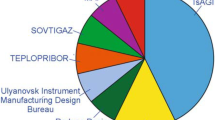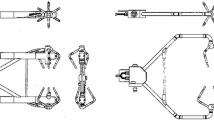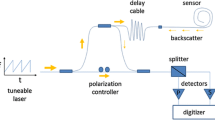Abstract
We have examined the potential of using a closed-path sensor to accurately measure eddy fluxes of CO2. Five inlet tubeflow configurations were employed in the experimental setup. The fluxes of CO2 were compared against those measured with an open-path sensor. Sampling air through an intake tube causes a loss of flux, due to the attenuation of CO2 density fluctuations. Adjustments need to be made to correct for this loss and to account for density effects due to the simultaneous transfer of heat and water vapor. Theory quantifying these effects is discussed.
The “raw” CO2 flux measured with the closed-path sensor was smaller than that measured with the open-path sensor by about 15% (on average) for the turbulent tubeflow configurations with a short (≈3 m) intake tube, by 31% for turbulent tubeflow with a longer (≈6 m) intake tube and by 24% for laminar tubeflow. The difference was, in part, caused by tube attenuation of the CO2 density fluctuations and inadequate sensor time response. The elimination of the flux adjustment for the simultaneous transfer of sensible heat (i.e., the attenuation of ambient temperature fluctuations in the intake tube) generally accounted for the rest of this difference.
The raw flux measured with the closed-path sensor was corrected for frequency response and density effects. Except in the case of laminar tubeflow, the corrected closed-path flux agreed consistently with the corrected open-path flux within a few percent (<5%). These results suggest that closed-path sensors, with appropriate corrections, can be used to measure CO2 flux accurately. Recommendations are included on selecting an “optimum” flow configuration to minimize the effect of sampling air through a tube.
Similar content being viewed by others
References
Baldocchi, D. D., Hicks, B. B., and Meyers, T. P.: 1988, ‘Measuring Biosphere-Atmosphere Exchanges of Biologically Related Gases with Micrometeorological Methods’,Ecology 69, 1331–1340.
Barton, N. G.: 1983, ‘The Dispersion of Solute from Time-Dependent Releases in Parallel Flow’,J. Fluid Mech. 136, 243–267.
Businger, J. A.: 1986, ‘Evaluating the Accuracy with which Dry Deposition Can be Measured with Current Micrometeorological Techniques’,J. Clim. Appl. Meteorol. 25, 1100–1124.
Campbell, G. S. and Unsworth, M. H.: 1979, ‘An Inexpensive Sonic Anemometer for Eddy Correlation’,J. Appl. Meteorol. 18, 1072–1077.
Chahuneau, F., Desjardins, R. L., Brach, E., and Verdon, R.: 1989, ‘A Micrometeorological Facility for Eddy Flux Measurements of CO2 and H2O’,J. Atmos. Oceanic Technol. 6, 193–200.
Fan, S., Wofsy, S. C., Bakwin, P. S., and Jacob, D. J.: 1990, ‘Atmosphere-Biosphere Exchange of CO2 and O3 in the Central Amazon Forest’,J. Geophys. Res. 95, 16851–16864.
Hartman, R. K. and Gay, L. W.: 1981, ‘Improvements in the Design and Calibration of Temperature Measurement Systems’, inProc., 15th Conf. Agric. For. Meteorol. 210 pp.
Hicks, B. B., Wesley, M. L., Coultier, R. L., Hart, R. L., Durham, J. L., Speer, R., and Stedman, D. H.: 1986, ‘An Experimental Study of Sulphur and NOx Fluxes Over Grassland’,Boundary-Layer Meteorol. 34, 103–121.
Incropera, F. P. and DeWitt, D. P.: 1981,Fundamentals of Heat and Mass Transfer, 2nd ed., John Wiley and Sons Inc., New York.
Kaimal, J. C., Wyngaard, J. C., Izumi, Y., and Cote, O. R.: 1972, ‘Spectral Characteristics of Surface-Layer Turbulence’,Quart. J. Roy. Meteorol. Soc. 98, 563–589.
Lenschow, D. and Raupach, M.: 1991, ‘The Attenuation of Fluctuations in Scalar Concentrations Through Sampling Tubes’,J. Geophys. Res. 96, 15259–15268.
Leuning, R. and Moncrieff, J.: 1990, ‘Eddy Covariance CO2 Flux Measurements Using Open- and Closed-Path CO2 Analysers: Corrections for Analyser Water Vapor Sensitivity and Damping of Fluctuations in Air Sampling Tubes’,Boundary-Layer Meteorol. 53, 63–76.
Massman, W. J.: 1991, ‘The Attenuation of Concentration Fluctuations in Turbulent Flow in a Tube’,J. Geophys. Res. 96, 15269–15273.
McMillen, R. T.: 1988, ‘An Eddy Correlation Technique with Extended Applicability to Non-Simple Terrain’,Boundary-Layer Meteorol. 43, 231–245.
Moore, C. J.: 1986, ‘Frequency Response Corrections for Eddy Correlation Systems’,Boundary-Layer Meteorol. 37, 17–35.
Ohtaki, E. and Matsui, M.: 1982, ‘Infra-Red Device for Simultaneous Measurement of Atmospheric Carbon Dioxide and Water Vapor’,Boundary-Layer Meteorol. 24, 109–119.
Philip, J. R.: 1963a, ‘The Theory of Dispersal during Laminar Flow in Tubes, I’,Aust. J. Phys. 16, 287–299.
Philip, J. R.: 1963b, ‘The Theory of Dispersal during Laminar Flow in Tubes, II’,Aust. J. Phys. 16, 300–310.
Philip, J. R.: 1963c, ‘The Damping of a Fluctuating Concentration by Continous Sampling Through a Tube’,Aust. J. Phys. 16, 454–463.
Taylor, G. I.: 1953, ‘Dispersion of Soluble Matter in Solvent Flowing Through a Tube’,Proc. R. Soc. London, Ser. A 219, 186–203.
Taylor, G. I.: 1954, ‘The Dispersion of Matter in Turbulent Flow Through a Pipe’,Proc. R. Soc. London, Ser. A 223, 446–468.
Verma, S. B.: 1990, ‘Micrometeorological Methods for Measuring Surface Fluxes’,Remote Sens. Rev. 5, 99–115.
Webb, E. K., Pearman, G. I. and Leuning, R.: 1980, ‘Correction of Flux Measurements for Density Effects Due to Heat and Water Vapor Transfer’,Quart. J. Roy. Meteorol. Soc. 106, 85–100.
Wesley, M. L., Eastman, D. R., Cook, D. R., and Hicks, B. B.: 1978, ‘Daytime Variations of Ozone Eddy Fluxes to Maize’,Boundary-Layer Meteorol. 15, 361–373.
Zeller, K., Massman, W. J., Stocker, D., Fox, D. G., Stedman, D. and Hazlett, D.: 1989, ‘Initial Results from the Pawnee Eddy Correlation System for Dry Acid Deposition Research,USDA For. Serv. Res. Pap. RM-282, U.S. Dept. of Agric. For. Serv., Fort Collins, CO.
Author information
Authors and Affiliations
Additional information
Published as Paper No. 9938, Journal Series, Nebraska Agricultural Research Division.
Rights and permissions
About this article
Cite this article
Suyker, A.E., Verma, S.B. Eddy correlation measurement of CO2 flux using a closed-path sensor: Theory and field tests against an open-path sensor. Boundary-Layer Meteorol 64, 391–407 (1993). https://doi.org/10.1007/BF00711707
Revised:
Issue Date:
DOI: https://doi.org/10.1007/BF00711707




